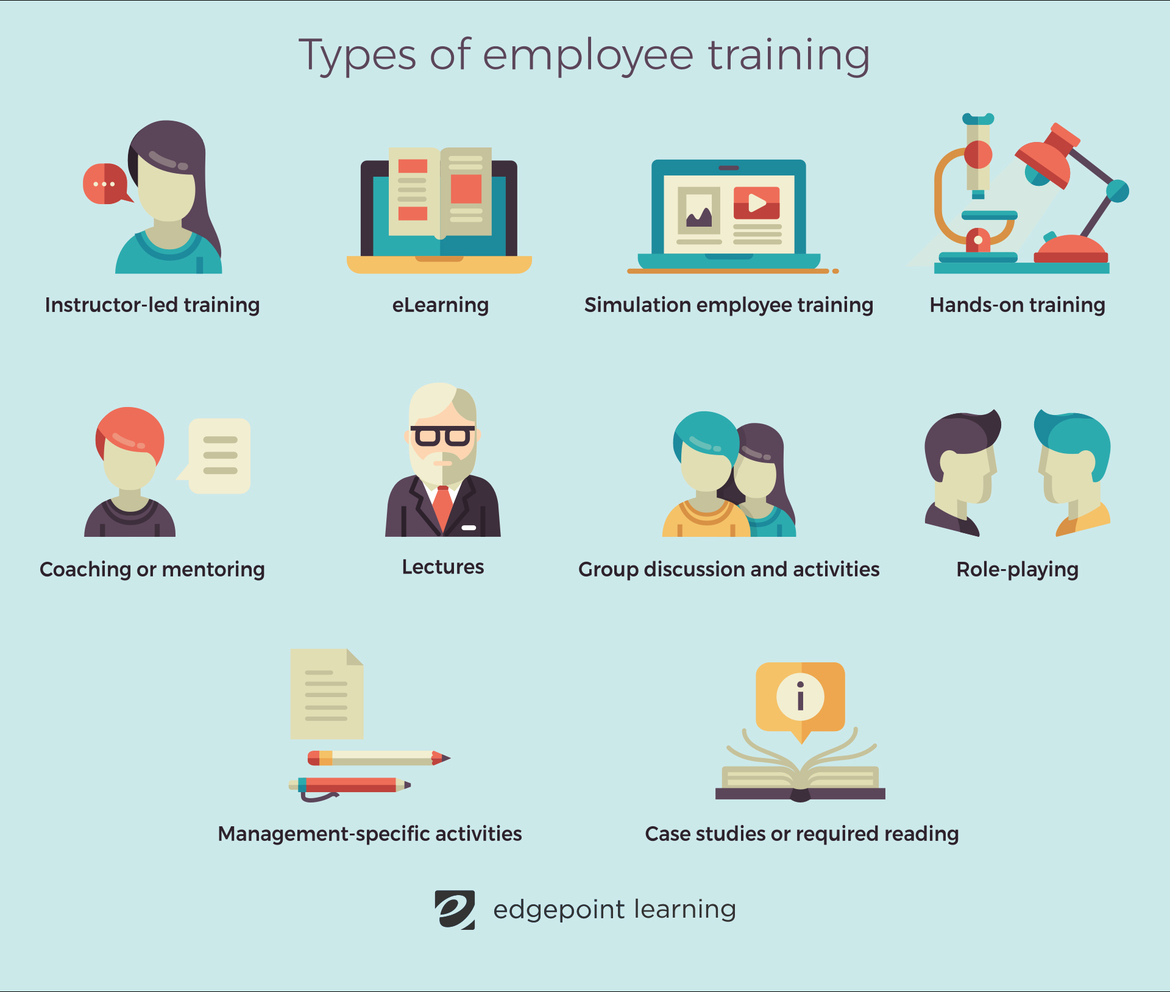Knowledge and skills are crucial to every company. Firms are evaluated based on their physical structure and intellectual capital. The easiest way to develop and improve a firm’s intellectual capital is to conduct regular
training and development programs.
Employee training and development refers to the continued efforts of a company to boost the performance of its employees. Companies aim to train and develop employees by using an array of educational methods and programs. The purpose of training and development in organizations is: Improve knowledge and skills to perform their roles effectively. Increasing employee productivity and efficiency. Support employee development and growth. If employees are working toward a goal, they are more likely to work harder and more efficiently.
There are benefits involved in the allover model of training and staff development.
There are sets backs that this might but the benefits outweigh the setbacks. The benefits include:
Improved employee performance the employee who receives the necessary training is more able to perform in their job. The training will give the employee a greater understanding of their responsibilities within their role, and in turn, build their confidence. This confidence will enhance their overall performance and this can only benefit the company. Employees who are competent and on top of changing industry standards help your company hold a position as a leader and strong competitor within the industry.
Reduced employee turnover

Staff is more likely to feel valued if they are invested in and therefore, less likely to change employers. Training and development are seen as additional company benefits. Recruitment costs, therefore, go down due to staff retention.
Addressing weaknesses
Productivity usually increases when a company implements training courses. Increased efficiency in processes will ensure project success which in turn will improve the company turnover and potential market share. A training program presents an opportunity to instill the needed skills in the employees. A development program helps to expand the knowledge base of all employees. In doing so, companies are able to bridge any gaps and weak links within their organizations. In such a way, every employee will be in a position to fill in for his colleague and handle any task with efficiency. Increased productivity and adherence to quality standards.
Boosts company profile and reputation
Employee training is not just good for the employees but also for the firm. Conducting frequent training and development programs is one way of developing the organization’s employer brand, thus making it a prime consideration for the top employees working for competitor firms, as well as graduates. A company that trains its employees will be more attractive to potential new employees, particularly those looking to advance their skills.
Innovation

When employees receive consistent training and upskilling, it fosters their creativity. The training programs help employees to be more independent and creative when they encounter challenges in their work.
Consistency
A robust training and development program ensures that employees have a consistent experience and background knowledge. The consistency is particularly relevant for the company’s basic policies and procedures. All employees need to be aware of the expectations and procedures within the company. Increased efficiencies in processes result in financial gain for the company.
Improved employee satisfaction and morale 
The investment in training that a company makes shows employees that they are valued. The training creates a supportive workplace. Employees may gain access to the training they wouldn’t have otherwise known about or sought out themselves. Employees who feel appreciated and challenged through training opportunities may feel more satisfaction toward their jobs.
Training employees can be done by the following training methods
Training is the process of providing employees with the necessary information and skills to develop their performance and improve their behavior in the work environment in order to obtain better results and to increase the production of the company or organization.

Coaching/Mentoring
Coaching/mentoring gives employees a chance to receive training one-on-one from an experienced professional. This usually takes place after another more formal process has taken place to expand on what trainees have already learned.
Orientation training
Orientation means providing new employees with basic information about the employer. Training programs are used to ensure that the new employee has the basic knowledge required to perform the job satisfactorily. Orientation training is crucial to the success of new recruits. It doesn’t matter whether the training is implemented through a handbook, a one-on-one session, or a lecture. What matters is providing new employees with information regarding the firm’s background, strategies, mission, vision, and objectives. Such training gives new employees an opportunity to familiarize themselves with company policies, rules, and regulations.
Computer-based training
3. (CBT) is any course of instruction whose primary means of delivery is a computer. A CBT course (sometimes called courseware ) may be delivered via a software product installed on a single computer, through a corporate or educational intranet, or over the Internet as Web-based training. With this approach, computers and computer-based tutorials are the primary means of communication between the trainer and employees. The programs are structured in such a way that they provide instructional materials while also facilitating the learning process. It also helps to reduce the total cost that an organization incurs in training its employees. Costs are minimized by reducing the training duration, eliminating the need for instructors, and reducing travel.
Management Games
Management games simulate real-life issues faced in the workplace. They attract all types of trainees including active, practical, and reflective employees.
Some examples of management games could include Computer simulations of business situations that managers ´play´.Board games that simulate a business situation.
Games surrounding thought and creativity - to help managers find creative ways to solve problems in the workplace, or to implement innovative ideas.
Case Studies
Case studies provide trainees with a chance to analyze and discuss real workplace issues. They develop analytical and problem-solving skills and provide practical illustrations of principles or theories. They can also build a strong sense of teamwork as teams struggle together to make sense of a case.
References
corporatefinanceinstitute: https://corporatefinanceinstitute.com/resources/careers/soft-skills/employee-training-and-development/
2020projectmanagement: https://2020projectmanagement.com/resources/project-management-training-and-qualifications/the-importance-of-training-and-development-in-the-workplace
Hr.com https://www.hr.com/en/communities/training_and_development/list-of-training-methods_eacwezdm.html.

Autonomous responsibility….
ReplyDeleteMelody hi staff and training are essential for the company because they are the brains and overseer mechanism for execution and mission development that drives the company and makes it tick! As CEO I cherished time building staff up and teaching just right amount of training. Like a spoke of a wheel evevything revolves around it! Also to teach your people that the company has goals and those goals are you and we are all going in same direction. Learn to complement each other in office and the field I told them we'll make more money and you will share in the profits! Teach the rest of the company these skills! I was generous with Bonuses! Happen regularly for Pro Property employees because we had such outstanding individuals working day and night to insure we would survive as a company. So I started handing out Bonuses! Birthday's Christmas and other bonuses. Travel Money etc. Best incentive and stimulate for the company, employees agreed, and for Andy to have happy employees.
ReplyDeleteThe essence is positive change on an individual and organizational level through performance improvement.
ReplyDeleteJohn
A training program allows you to strengthen those skills that each employee needs to improve.
ReplyDeleteA development program brings all employees to a higher level so they all have similar skills and knowledge.
This helps reduce any weak links within the company who rely heavily on others to complete basic work tasks.
Love your employees
ReplyDeleteEstablish a core value
“Make our company the garden where people go to grow”
Start a formal company university
Growth
ReplyDeleteTrained people are more professional, motivated, and work more effective. Work smarter not harder.
ReplyDeleteRelevance to the job. If the training is not relevant, as in bona fide job tasks and company goals, it is is not worth much.
ReplyDeleteCompetence. If the training staff don’t know the job but know how to teach, they may get the training wrong. If they know the job, but don’t know how to teach, they won’t convey the required information. They have to know the job and know how to teach.
It is an ongoing process - not just a time-centered benchmark
ReplyDeleteUnderstanding the potential of the person. If you can see which training could really benefit them, as well as the company, everyone will benefit.
ReplyDeleteTalk to your staff, see what gets them excited and train their hidden talents. Bring out their best, they will be forever grateful and loyal, and the company will have spent their training budget wisely, with good returns on investment!
Think the true essence of training and staff development is.
ReplyDelete1 know your product.
2. Make it fun
3. Have examples on hand
4. Involve people … maybe do an experiment with staff participation it makes it more interesting
5. Offer a quiz xx
There are so many modules available on line on this topic. Mainly depends upon dedication towards duty and respect for duty.
ReplyDelete“Essence"… That's the stuff that oozes out of the end of the meat grinder of a training session. Little bits and pieces of staff, I believe.
ReplyDeleteHi,
ReplyDeleteReliability, improvement, and self-management.
I think the best thing for a manager to do is to show respect for the employee. You can do this by asking — and taking their opinion, which shows they are part of a team and respected. I think it helps if you know their job. I used to cover for people when they went on vacation or out sick. It showed people I knew their job. It’s demoralizing when the boss doesn’t know what you do. When they returned, I would always chat with then about frustrations in their job (bottlenecks, lack of proper info, etc.) This was a a burden on me, but working late has always been the lot of managers, and it forced me to work more efficiently. It is truly amazing the perspective you get on an organization when you work at a lower level.
ReplyDeleteThe only answer that comes to mind for me is:
ReplyDeletePersonals growth and growth within a field or career and in the service of organizational development.
We provide training to staff in order to enable them to do a new job or a better job, which is usually accompanied by some personal growth. We attempt in this way to contribute to developing the organization.
That’s pretty brief and I hope close to the essence. And I hope it helps.